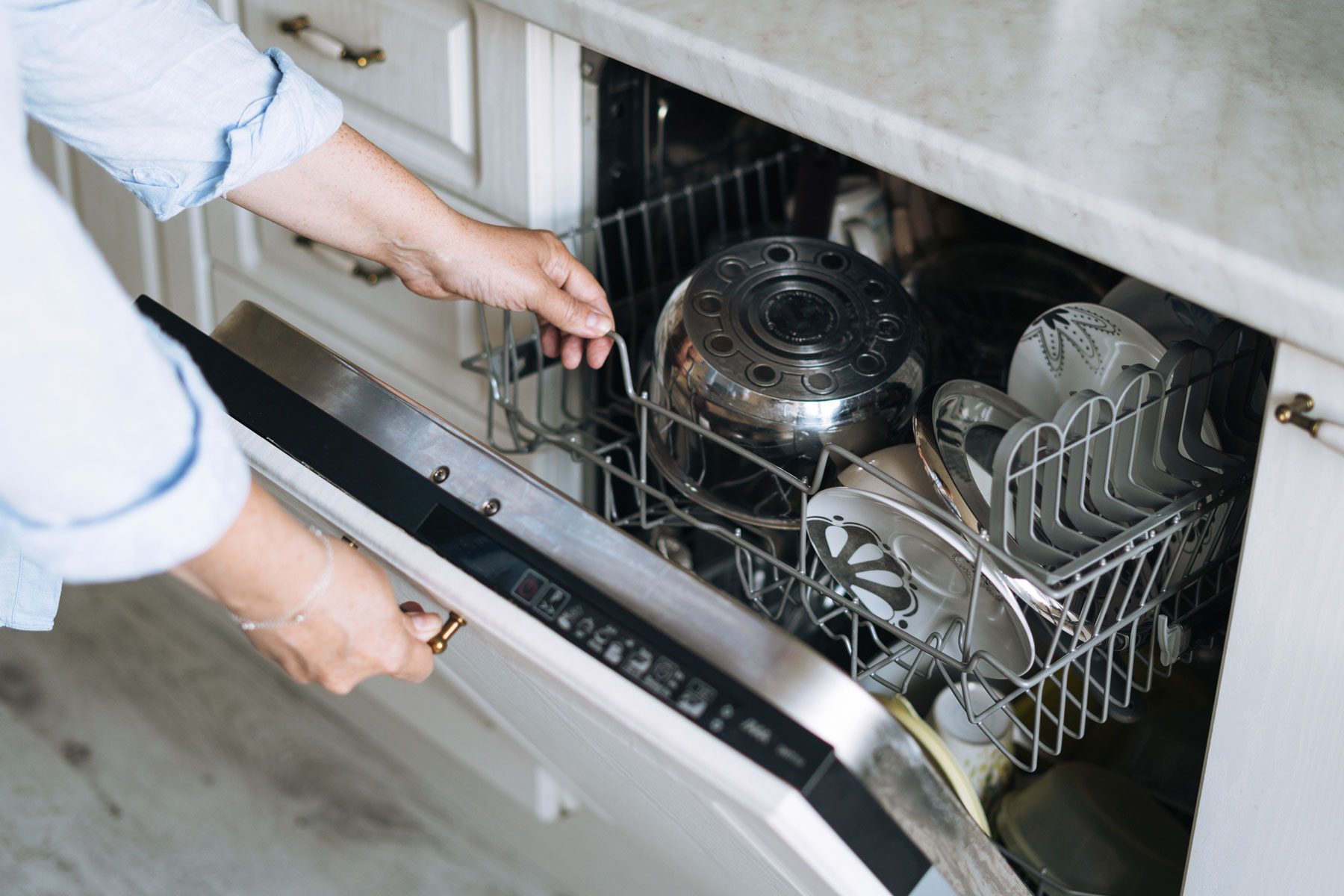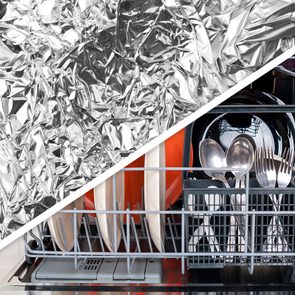Stop scrubbing! Let this clever dishwasher compartment do the heavy lifting.

You Probably Don’t Know About This Hidden Compartment in Your Dishwasher

When you cook a big family dinner, filling your kitchen with bubbling pots of pasta and casserole pans with baked-on cheese, do you trust your dishwasher to clean those dishes when it’s all over? Or do you spend hours soaking, scrubbing and washing them by hand?
If you’re getting wrinkly fingers standing over the sink while your family chills in front of the TV or you’re still prerinsing dishes before loading the dishwasher, have I got news for you: Your dishwasher can handle it! In fact, there’s a little-known dishwasher compartment that does the dirty work for you.
I spoke with cleaning and dishwashing expert Alicia Sokolowski of AspenClean eco-friendly cleaning supplies and cleaning services to get the scoop. So read on to learn all about this not-so-dirty little secret. You better believe it’s going to save you tons of time and frustration.
Get Reader’s Digest’s Read Up newsletter for more cleaning, humor, travel, tech and fun facts all week long.
Why is grease so hard to clean?
Grease is hydrophobic, which literally means “water-fearing,” but given its inanimate status, you can think of it more like “water-repelling.” In other words, grease molecules do not mix readily with water, so they are difficult to remove from surfaces without the intervention of detergent and heat.
You also have surface tension to deal with. When a bunch of water molecules get together, whether in a glass, a lake or your sink full of dirty dishes, they’re strongly attracted to one another. That’s why you can float a pin in a cup of water and why bugs can skate over the surface of a puddle without falling in.
Ancient humans discovered that soap, made from fats and ashes, got their stuff clean by making plain water work better. More recently, we started synthesizing detergents instead of using natural soap. Dishwasher detergents, like other modern grease-cutting cleaning agents, contain surfactants to cut through the surface tension and bind to the grease on your dishes. Once the grease is captured by the surfactants, water simply rinses it away.
What secret spot in your dishwasher can help tackle this problem?

It’s the prewash compartment! This unobtrusive little slot, cup or divot can be a little hard to spot, and if you haven’t read your manual cover to cover or peered into your dishwasher with an eagle eye, you might have missed it.
“The prewash/rinse compartment in your dishwasher is designed to hold the detergent for the initial cleaning phase,” Sokolowski says. (You may also see this called a prerinse compartment because your dishwasher uses warm water to rinse your dishes before the main wash.)
“This is supposed to help loosen the stuck-on food and grease before the main wash cycle starts, ensuring a deeper cleaning during the main dishwashing cycle,” Sokolowski says. So even though dishwasher detergents are formulated to cut through dirty grease and grime, sometimes they need a bit longer to do it, and the prewash compartment can help.
Do all dishwashers have this compartment?
Most do, but some—especially older models—may not have this feature. How can you find out? Take a peek at the inside of the door or wherever you add your dishwashing liquid, powder or pod. On my KitchenAid, the prewash compartment is a tiny indentation on top of the main wash compartment. Other dishwashers have a deeper, narrower slot next to the main compartment.
Prewash compartments don’t usually have a locking door or flap. That makes sense: Detergent in the prewash compartment helps during the initial cycle and doesn’t need to wait for a door to pop open later.
Some internet sleuths have noticed their secret prewash divot is inside the primary wash compartment. As you can see in the picture above, this compartment is covered by open slats, at least in some models, so the detergent can be accessed in this early prerinse stage.
What do you put in the prewash component?
Just put in a little extra liquid or powder dishwashing detergent, Sokolowski says. And by “a little,” she means it. My compartment barely holds a teaspoon! Modern dishwashers are designed to be efficient and clean dishes with less water than in years past, so if you pile on too much detergent, you could have rinsing problems.
If you’re a pod user, know that these compartments are not designed to hold an extra pod, Sokolowski says. First of all, pods are unlikely to fit into a narrow prewash slot. And second, the tiny divots on top (like mine) are meant for much smaller amounts of detergent. Sokolowski advises restraint.
Most dishwasher pods “are nowadays formulated to be sufficient without a need for prerinse, as they are meant to tackle even the tough food residues throughout the regular wash cycle,” Sokolowski says. “If there’s any extra cleaning necessary, you can add a second pod at the bottom of the dishwasher, but this is rarely needed.”
How to use the prewash compartment
Ready to get last night’s greasy, stuck-on lasagna dishes clean as a whistle? Here’s what to do:
- Scrape your dishes, but don’t prerinse. Today’s dishwashers and dishwasher detergents don’t need it.
- Load your dishwasher. Place larger, dirtier items on the bottom rack, face down toward the jets. Don’t block the detergent compartment with trays or other large dishes.
- Fill the main wash compartment with detergent, and close the lid. If your prewash slot is within the main compartment, fill it with a small amount of detergent before closing the lid.
- Add detergent to your prewash slot if it isn’t within the main detergent compartment. Fill it to the marked line (if there is one) or to the top of the compartment. Don’t overfill.
- Fill the rinse-aid compartment with a rinsing agent if it’s low. Rinse aids prevent spots from forming on your dishes and are especially helpful if you have hard water.
- Close the door and select the cycle according to your manual’s recommendations. Some machines will have a specific prewash or heavy-duty cycle. The prewash detergent will be introduced in the initial rinse.
What else do you need to know about using the prewash compartment?
Using the prewash compartment is pretty simple, but I just had to ask Sokolowski: What happens to all the greasy, gross food that the prewash breaks free? And do you need an extra rinse or anything?
It’s a little gross to think about, but “the extra food leftovers and grease are usually caught by the dishwasher filter and then flushed out through the drain,” Sokolowski says. That’s why she says it’s important to clean your filter regularly, especially if you notice clogs or bad smells. (Check your dishwasher manual for details and frequency.) “You should also make sure to run a deep-cleaning cycle using baking soda and vinegar, ideally once a month, to ensure your dishwasher runs efficiently,” she adds.
But don’t worry about doing a second rinse after the prewash cycle, Sokolowski says. “The detergent in the dedicated container is rinsed away during the initial rinse cycle,” she explains. “You don’t need an extra rinse unless you notice residue on your dishes or have hard-water issues.”
How well does this prewash compartment work?
It works great! I made a big pot of spaghetti last night, and of course, I had to add freshly grated Parmesan cheese. Would it have been better (and cleaner) to sprinkle it on individual portions? Sure, but we like to stir it in and get the 3-quart pan all melty and cheesy.
Before bed, I loaded the dishwasher, and with Sokolowski’s tips fresh in my mind, I added a little dollop of detergent to the prewash divot. I chose the ProWash cycle, which senses the soil level automatically, and went to bed. This morning, my dishes were spotless, with no globs of cheese or tomatoes in sight. I didn’t run a control load, of course, but given the state of my dinnerware and the ease of adding just a tiny amount of extra detergent, I’ll take this result happily.
About the expert
|
Why trust us
At Reader’s Digest, we’re committed to producing high-quality content by writers with expertise and experience in their field in consultation with relevant, qualified experts. We rely on reputable primary sources, including government and professional organizations and academic institutions as well as our writers’ personal experiences where appropriate. For this piece, Ally Childress tapped her experience as a journalist who covers home and cleaning for Reader’s Digest. We verify all facts and data, back them with credible sourcing and revisit them over time to ensure they remain accurate and up to date. Read more about our team, our contributors and our editorial policies.
Sources:
- Alicia Sokolowski, founder and co-CEO of AspenClean; email interview, Nov. 18, 2024
- American Cleaning Institute: “The Science of Soap”
- United States Geological Survey: “Surface Tension and Water”



